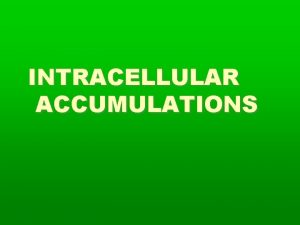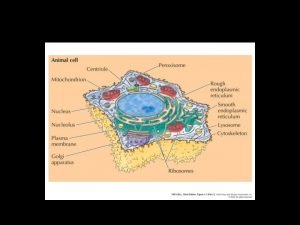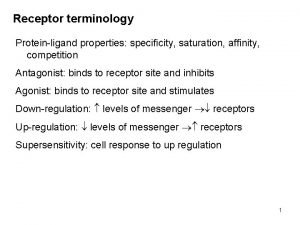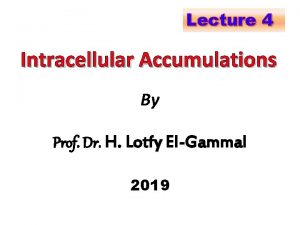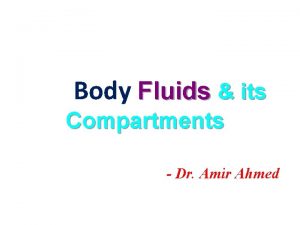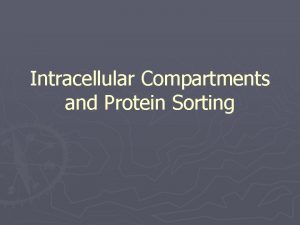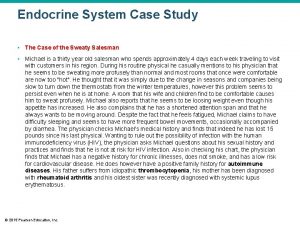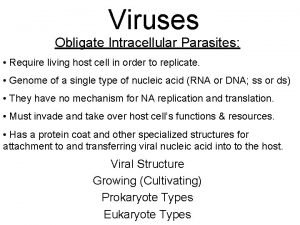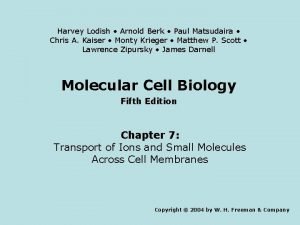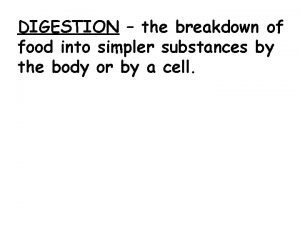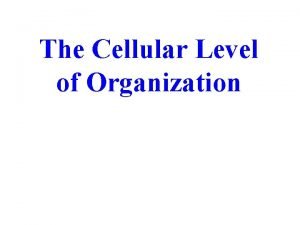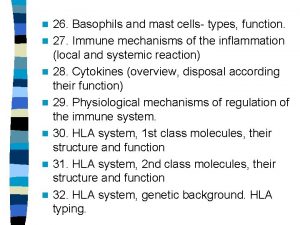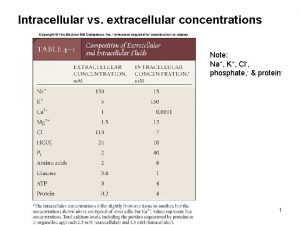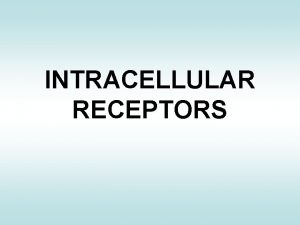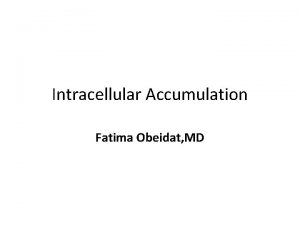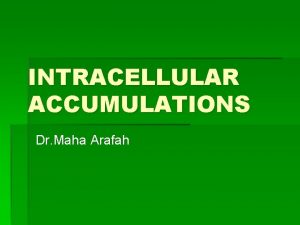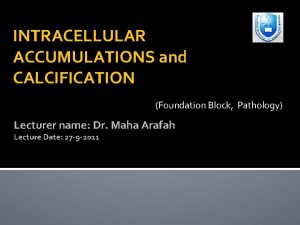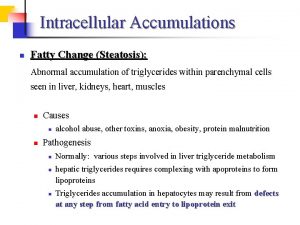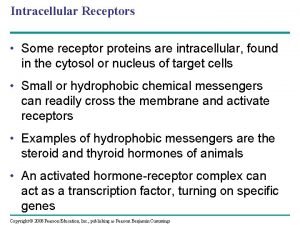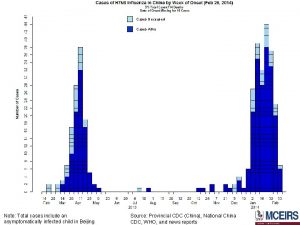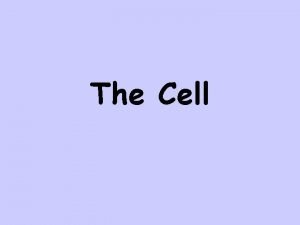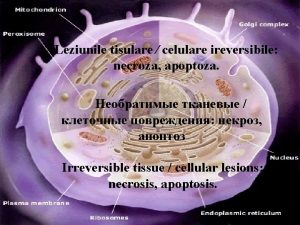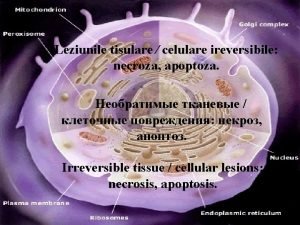INTRACELLULAR ACCUMULATIONS Overview In some cases of cell


























- Slides: 26

INTRACELLULAR ACCUMULATIONS

Overview In some cases of cell injury cells may accumulate abnormal amounts of various substances. They may be harmless or associated with varying degrees of injury.

Overview Location: in the cytoplasm within organelles (typically lysosomes) in the nucleus Source: Synthesis by affected cells Produced elsewhere

Pathways normal substance Normal or increased rate of production of but metabolic rate is inadequate to remove it (e. g. fatty change in liver)

Pathways normal or an abnormal endogenous substanceaccumulates because of genetic or acquired defects in its folding, packaging, transport, or secretion. e. g. α-1 antitrypsin deficiency, accumulate in the liver causing cirrhosis)

α-1 antitrypsin deficiency

Pathways An inherited defect in an enzyme - results in failure to degrade a metabolite. The resulting disorders are called storage diseases.

Pathways An abnormal exogenous substance is deposited & accumulates because the cell has neither the enzymatic machinery to degrade the substance nor the ability to transport it to other sites. e. g. Accumulations of carbon or silica particles

Fatty Change Fatty change refers to any abnormal accumulation of triglycerides within parenchymal cells. Site: liver, most common site also in heart, skeletal muscle, kidney, other organs.

Causes of Fatty Change Toxins (most importantly: Alcohol abuse) diabetes mellitus Protein malnutrition (starvation) Obesity Anoxia

Starvation will increase this Hepatotoxins (e. g. alcohol) by disrupting mitochondria and SER ; anoxia • Defects in any of the steps of uptake, catabolism, or secretion can lead to lipid accumulation. CCl 4 and protein malnutrition

Morphology of fatty change Most common site: the liver and the heart. With increasing accumulation, the organ enlarges and becomes progressively yellow, soft, and greasy.


Light of microscopy fatty change Early: small fat vacuoles in the cytoplasm around the nucleus. Later stages: the vacuoles coalesce to create cleared spaces that displace the nucleus to the cell periphery Occasionally contiguous cells rupture (fatty cysts)

Cholesterol and Cholesteryl Esters

Conditions associated with Cholesterol and Cholesteryl Esters accumulation Several different pathologic processes: 1. Macrophages in contact with the lipid debris of necrotic cells or abnormal (e. g. , oxidized) forms of lipoproteins

Atherosclerosis: These give atherosclerotic plaques their characteristic yellow color and contribute to the pathogenesis of the lesion


Conditions associated with Cholesterol and Cholesteryl Esters accumulation 3. In hereditary and acquired hyperlipidemic syndromes, macrophages accumulate intracellular cholesterol 4. Xanthomas: clusters of foamy macrophages present in the subepithelial connective tissue of skin or in tendons

Morphologically visible protein accumulations are much less common than lipid accumulations They may occur because excesses are presented to the cells or because the cells synthesize excessive amounts

Protein accumulations Example: 1. Nephrotic syndrome: In the kidney trace amounts of albumin filtered through the glomerulus are normally reabsorbed by pinocytosis in the proximal convoluted tubules After heavy protein leakage, pinocytic vesicles containing this protein fuse with lysosomes, resulting in the histologic appearance of pink, hyaline cytoplasmic droplets

The process is reversible; if the proteinuria abates, the protein droplets are metabolized and disappear.

Protein accumulations Example: 2. marked accumulation of newly synthesized immunoglobulins that may occur in the RER of some plasma cells, forming rounded, eosinophilic Russell bodies.

Protein accumulations Example: 3. Mallory body, or "alcoholic hyalin, " is an eosinophilic cytoplasmic inclusion in liver cells that is highly characteristic of alcoholic liver disease These inclusions are composed predominantly of aggregated intermediate filaments

Protein accumulations Example: 4. The neurofibrillary tangle found in the brain in Alzheimer disease is an aggregated protein inclusion that contains microtubule-associated proteins

Glycogen Associated with abnormalities in the metabolism of either glucose or glycogen. Examples: 1. In poorly controlled diabetes mellitus, glycogen accumulates in renal tubular epithelium, cardiac myocytes, and β cells of the islets of Langerhans. 1. Glycogen accumulates within cells in a group of closely related genetic disorders collectively referred to as glycogen storage diseases, or glycogenoses
 Intracellular accumulations
Intracellular accumulations Criminal cases vs civil cases
Criminal cases vs civil cases Bioimpedância
Bioimpedância Extracellular fluid
Extracellular fluid Intracellular receptors
Intracellular receptors Intracellular accumulation
Intracellular accumulation Hypoosmotic
Hypoosmotic Lipofuscin
Lipofuscin Intracellular fluid and extracellular fluid examples
Intracellular fluid and extracellular fluid examples Ecf icf and interstitial fluid
Ecf icf and interstitial fluid Intracellular compartments and protein sorting
Intracellular compartments and protein sorting Intracellular hormone binding
Intracellular hormone binding Escherichia virus t4
Escherichia virus t4 Youtube.com
Youtube.com Intracellular ph regulation
Intracellular ph regulation Intracellular digestion
Intracellular digestion Intracellular structure
Intracellular structure Neurotrasmiters
Neurotrasmiters Intracellular accumulation
Intracellular accumulation 9 13
9 13 Nuclear receptor
Nuclear receptor Cell signaling overview
Cell signaling overview They say it only takes a little faith to move a mountain
They say it only takes a little faith to move a mountain They say it only takes a little faith to move a mountain
They say it only takes a little faith to move a mountain Cake countable or uncountable
Cake countable or uncountable What is contact force
What is contact force Some say the world will end in fire some say in ice
Some say the world will end in fire some say in ice
